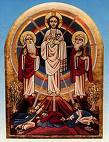A Day on the Isle of Wight
Abbot Cuthbert, Abbot Anselm and I found our way to a ferry across the Solent shortly after the conclusion of Mass yesterday morning. there, we first visited the nuns of St. Cecilia's, Ryde. We were graciously received by their extern sister (the rest of the community lives within a strict enclosure), who led us to the parlor where we visited a time with two of the nuns. After the office of Sext and a hearty lunch in honor of St. Luke, we visited with the whole community, consisting of about 25 nuns.
Like Farnborough, the site at Ryde was a foundation of Solesmes at the time of the 'Laws of Association' in France in 1901. These laws prohibited associations that were not approved by the state. This was a direct attempt to stamp out religious life in France. In any case, nuns were sent to Ryde. In another interesting parallel to Farnborough, the French sisters eventually departed and a group of English nuns from Ventnor (at the south end of the Isle) took over the house. They remain, however, affiliated with Solesmes. Hence, the whole of the liturgy was in Latin, well done, I might add.
We visited with the 'venerable' Sister Bede in the afternoon. She is a well-known illuminator and iconographer. She examined some manuscript work we had brought from Farnborough and identified some of the work as her own, some of it as by other sisters. Sister Mary David, an American, also visited with us.
From there, we journeyed a short distance by car to Quarr Abbey, which was the primary place of refuge for Solesmes. The architecture here is most beautiful, done in exquisite brick work patterned after models from Moorish Spain. We joined them for Vespers and, happily, the clothing of a novice.
The community at Quarr numbers about twelve, which is a bit small for the buildings designed to house closer to ninety. Nonetheless, it is a young and vigorous group with an impressive amount of work going on. As befits a Solesmes house, the liturgy was again in Latin. We did not, however, drink our wine from bowls--a reminder that we were still in England and not in France.
From the roof of the abbey, one can see both Portsmouth and Southampton on the main island. I am told that the Isle of Wight was the residence of Queen Victoria and the place where she died. Today the north coast at least seems primarily an attraction for vacationing senior citizens.
These two communties bring to ten the number of Benedictine houses I've visited since August. One can't help but be impressed by the terrific variety and individuality of different communities coexisting with a clear, solid core of monastic practice centered on the praying of the divine office. Each community is a grand story featuring bright characters, heart-rending crises and edifying triumphs of perseverance and grace.

No comments:
Post a Comment